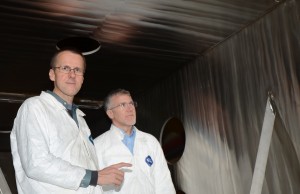Electron beams aren’t just for colliding. They also happen to be useful tools for welding metals and treating greenhouse gases.
PAVAC Industries of Richmond, Canada is all about electron beams – manipulating them and manufacturing machines that use them. The company is currently contracted to develop superconducting radiofrequency technology (SRF) for the ILC. That assignment, along with an entrepreneurial desire to expand, has given the business both impetus and incentive to grow.
Last year PAVAC successfully expanded into the US, establishing a second location a stone’s throw from Fermilab in Batavia, where they’ll eventually produce ten accelerator cavities for ILC research.
“I wanted to go to Arizona because there’s sun and it’s warm – a nice place to be, especially in winter,” said PAVAC President Ralf Edinger.

PAVAC President Ralf Edinger (left) and associate Doug LaPointe inspect a vacuum chamber the company is manufacturing for an electron beam welder. Image: Ralf Edinger
The opportunity to develop forward-leaning accelerator know-how for a major science project trumped happy weather. Edinger recognised that developing SRF was beneficial, not only for physics programmes, but for positioning PAVAC at the cutting edge of technology.
In the early days of PAVAC, the company made its mark on electron beam systems by manufacturing electron beam welding (EBW) machines. Selling machines continues to bring in the greatest portion of its revenue.
Then in 2004, TRIUMF laboratory in Vancouver, Canada, approached PAVAC to develop SRF cavity prototypes for a project called ISAC 2. SRF looked to be a viable market, but as the company was looking to expand beyond the Canadian border, it seemed that expansion through SRF was a goal without an application.
“The problem was, we had a target, but no purpose,” Edinger said.
In 2008, Fermilab’s Mark Champion recruited PAVAC in his search for potential North American cavity vendors for the ILC.
“The work on the ILC, having to achieve milestones, gave us a purpose,” Edinger said. “You don’t get rich developing cavities, but it’s a very good way to drive your technology. That’s the key element.”
About that time the International Atomic Energy Agency began pushing for cutting-edge ways to clean up greenhouse house gas emissions. Edinger participated in an IAEA working group to develop beam sources to deliver high power to gas treatment processes.
“If all this technology is developing with ILC-type RF accelerators, can’t that knowledge base be used to develop a new accelerator that we can then introduce into industrial facilities?” Edinger said.
Last month PAVAC and Fermilab entered into a US Department of Energy Work for Others agreement in which Fermilab lends to PAVAC its accelerator-based capabilities, enabling the company to develop a gas treatment system. In the longer term, PAVAC could be a resident at the future Illinois Accelerator Research Center, perhaps building a prototype electron beam flue gas treatment plant in Saskatchewan, Canada.
“So from the work on cavities, we’re branching out into other areas,” Champion said. “It’s a great example of accelerator applications.”
Though the move to the Chicago suburb will provide little respite from Richmond’s rain, it’s a good fit for PAVAC. The area has an established machine-making and tool-building infrastructure. Machine part wholesalers are right around the corner. Subassembly manufacturing is increasingly drawn to the city.
The move also positions the company to work closely with and provide electron beam welding for Argonne National Laboratory, also outside Chicago, and Michigan State University in nearby Lansing.
Beyond America, the company has a contract to sell an EBW machine to the RRCAT laboratory in Indor, India.
“Ralf became better known in the community,” Champion said. “Many things have come from PAVAC’s work with SRF. But it was the ILC programme that really stimulated it and enabled this.”
The company has also continued developing methods to ablate materials with electron beams, vapourising metals and then depositing the vapour on various surfaces.
“There is a need for a lot of cool technologies that really drive the future and SRF is probably one way of doing that,” Edinger said. “It might not be SRF as we do it today, but if you push this envelope further, maybe you come up with something out of it.” And that something may very likely be as good for business as it is for science applications.

Recent Comments